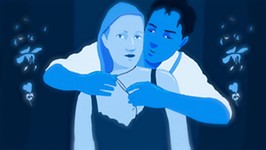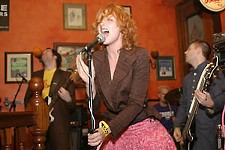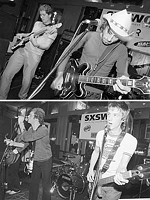Tokyo Drifter & Branded to Kill
Japanese filmmaker Seijun Suzuki was fired from his film company for his off-the-wall cinematics; these two Sixties gangster movies explain why.
Reviewed by Jerry Renshaw, Fri., Dec. 1, 2000
Tokyo Drifter
(aka Tokyo Nagaremono)D: Seijun Suzuki (1966); with Hideaki Esumi, Chieko Matsubara, Tamio Kawaji.
Branded to Kill
(aka Koroshi No Rakuin)D: Seijun Suzuki (1967); with Jo Shishido, Koji Nambara, Isao Tamagawa, Hiroshi Minami. Critic Andrew Sarris said about Samuel Fuller's films that "they have to be seen to be understood." Sarris' remark holds true for these two Suzuki movies as well, but it might be wise to change that phrase to "they have to be seen to be believed." They're both Japanese yakuza genre films that are rendered nearly unrecognizable by director Suzuki. Tokyo Drifter's sketchy plot concerns a hit man determined to go straight, along with his boss, but the pair are too deeply entwined in the underworld to break free. Hitman Shootin' Star (Watari) offers his life, along with the deed of a building belonging to his boss, as ransom for a debt to a rival gangster. When things become too hot in Tokyo, Shootin' Star decides to become a drifter for a while, leaving his father-figure boss behind. The free-agent life doesn't fly too far before he's approached by other gangs to act as a hired gun. The nominal plot seems fairly conventional, but in Suzuki's film, story is nothing and style is everything. The film jerks from one bizarre set-piece to the next. The movie's opening segment has the hero getting the living crap kicked out of him in a railyard; it's filmed in extremely high-contrast black-and-white that leaves hardly any shades of gray. The newsreel graininess of the scene is broken only by certain key objects that are highlighted in colors so bright they almost have a neon tint. Abruptly things go to color, and what a use of color -- the hero spends much of the movie wearing a powder-blue suit, sunglasses, and white bucks. Dour scenes of exposition will cut away to segments in which the protagonist's girlfriend sings cheesy lounge-style ballads in sets lit with garish pastels. Hipsters dance stiffly in a lavender discotheque while off-kilter Sixties Japanese rock blasts away. The hero whistles his own lugubrious theme song, amid the macho bluster and bravado of his scenes. Like a Fifties Vincente Minnelli musical, color is used to highlight mood and tone of various scenes, except it's pushed to the point of absurdity. Tokyo Drifter also generously mocks the conventions of the gangster movie and even pokes fun at itself. It's worth remembering that the drifting renegade gunman is a staple of the Western, and Tokyo Drifter's nod to the Western is a bar fight in an Old West saloon, complete with a sign reading "Saloon Western" on the window and a honky-tonk piano pounding away in the background. Gunmen pull off incredible feats of marksmanship, shooting guns out of each others' hands. The movie's finale is a gunfight that takes place in a blinding white set, with Shootin' Star wearing a white suit and two or three white grand pianos scattered around -- it's like what might happen if Orson Welles tried LSD. Tokyo Drifter is an exercise in pure style, but it's a dizzying grab bag of styles with vertiginous editing, camera work that's sometimes lyrical and sometimes inept, and a plot that's almost completely incomprehensible. In the end, it's all wrapped up in age-old Japanese themes of honor and betrayal. The end result is a fascinatingly brain-spraining and eye-twisting movie that's too weird to even be classified as camp.
Suzuki's Branded to Kill is equally strange but in a completely different way. Shishido plays Number Three, a professional assassin who's hired to rub out an important political figure. Shishido apparently thought that he needed to look more Western, so at some point, he had huge collagen injections in his cheekbone area. With cheeks that look like he has a bad case of the mumps, Shishido is distracting as hell just by way of his presence onscreen; his plastic surgery turned him into something of a monster in the long run. Number Three carries out his deadly job with cool detachment and nonchalance. When the big job comes around, though, a butterfly lights on the barrel of his rifle in front of the rifle's scope. He misses his shot and kills a bystander instead; after this debacle, Number Three is on the run and in deep trouble with two separate gangs. All his friends are out to get him, and even his wife turns into a femme fatale. Hit man Number One finally brings him to ground, playing a sadistic game of cat-and-mouse that winds up with the two handcuffed together, the senior assassin breaking him down with mental torture. Again, Branded to Kill's plot isn't too far off the beaten track, but the movie's execution is something completely different. The beauty is in Suzuki's attention to the finer details of character and action. Number Three's stone-cold façade is broken by one thing -- the smell of boiling rice (presumably an obsession that would nail him down as quintessentially Japanese). More than once, he walks into a bar and orders the bartender, "Boil rice!" The love/hate relationship with his wife is played out in acrobatic sex scenes that are surprisingly rough and intense. Guns are fetishized in a way that's reminiscent of Woo or Tarantino; when Number Three and Number One finally meet, they jam pistols into each other's faces for a Woo-style standoff. Filmed in razor-sharp black-and-white, the film winds up being more French New Wave than Japanese, with a cool jazz score and editing that turns it into a minimalist gem. It brings together elements of American noir, avant-garde abstraction, and beatnik sensibilities for a film that's more nihilistic than Robert Aldrich's Kiss Me Deadly. Think Godard with a hell of a lot more action, sex, gunplay, and spent brass bouncing off the floor. Taken together, these two movies are brilliant, but in ways that are so unlike each other that they hardly seem like they could have come from the same director. Suzuki's films were considered so weird and inaccessible for the time that he was fired from the company he worked for and blackballed from making movies in Japan for several years. Either one of these films is likely to be the most off-the-wall gangster movie you'll ever lock eyes on for 90 minutes.










